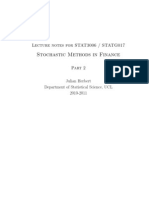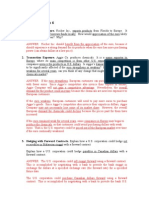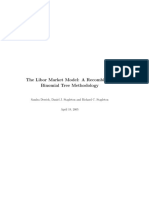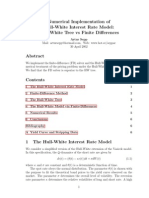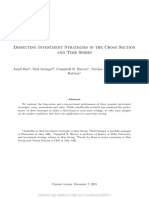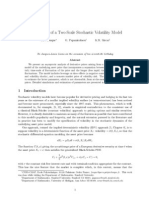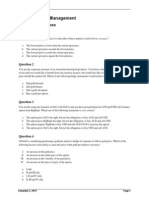Lecture 2 A
Lecture 2 A
Uploaded by
Stanil StoevCopyright:
Available Formats
Lecture 2 A
Lecture 2 A
Uploaded by
Stanil StoevOriginal Title
Copyright
Available Formats
Share this document
Did you find this document useful?
Is this content inappropriate?
Copyright:
Available Formats
Lecture 2 A
Lecture 2 A
Uploaded by
Stanil StoevCopyright:
Available Formats
MFIN 7003 Mathematical Techniques of Finance I: Jin E Zhang
Lecture 2a: Dimension analysis of the Black-Scholes formula, No-arbitrage theory and Put-call parity
1. Dimension analysis of the Black-Scholes formula Dimension analysis is often used in physics to study the similarity structure of a certain phenomenon. For example, the air ow outside of an airplane is often controlled by a single factor called Mach number, which measures the relative velocity of the airplane over the speed of sound. The dimension analysis is introduced here in quantitative nance to study the intrinsic nature of option price and to determine the key factors that govern the price law of an option. After some analysis, we will
MFIN 7003 Mathematical Techniques of Finance I: Jin E Zhang
see that the non-dimensional option price is indeed controlled by only two factors, instead of six in the original Black-Scholes formula. One is the moneyness and the other one is the standard deviation of stock return over the period from now until maturity date. 1.1 Dimension Dimension is dened to be unit here. Dimensionless variable is a variable that has no dimension. We often use a square bracket [ ] to denote the dimension of a variable. For example, the dimension of your height is meter. This
MFIN 7003 Mathematical Techniques of Finance I: Jin E Zhang
statement can be written as [h] = m, where h is a variable height and m is meter. Similarly we can write [St] = $, [ct] = $, [K ] = $, [Ker(T t)] = $,
where $ stands for dollar. We also have [T ] = [t] = year, [r ] = 1 , year [ 2] = 1 , year [ ] = 1 , year
so that r(T t) and T t are dimensionless. The ratio between the current stock price, St, and the current
MFIN 7003 Mathematical Techniques of Finance I: Jin E Zhang
value of strike price, Ker(T t), is dimensionless, i.e., St Ker(T t) has no dimension. The concept of dimension has many applications. One important application is that it can be used to judge whether a complicated formula is correct or not. For example, ct = N (d1) Ker(T t)N (d2) is a wrong formula, because the rst term has no dimension and the dimension of the second term is dollar. Two variables with dierent dimensions cannot be subtracted each other.
MFIN 7003 Mathematical Techniques of Finance I: Jin E Zhang
The following formula ct = StN (d1) Ker N (d2) is not correct either, because the interest rate r has a dimension 1/year, er does not make sense. The independent variable of the exponential function has to be dimensionless. With a clear concept of dimension in mind, one could build an intuition with complex mathematical formula more quickly and have a less chance to make a mistake. Dimension analysis of nancial quantities helps you to remember the formula. 1.2 Moneyness We now introduce a new concept called Moneyness, which is
MFIN 7003 Mathematical Techniques of Finance I: Jin E Zhang
dened to be variable by following = St Ker(T t) 1. (1)
We explain why this term is called moneyness. For a call option, if St > Ker(T t), the call option is called in-the-money. The owner of the option is likely to gain if an in-the-money option is to be exercised on maturity date. In practice, the interest rate eect is small, i.e., er(T t) often uses St 1 K to dene the moneyness. But the denition (1) is more reason1
1 1, one
r(T t)
When interest rate and time to maturity are small, for example, r = 0.05, T t = e0.004 = 0.996 1, here we apply the Taylor expansion to have ex 1 + x.
1/12, then r(T t) = 0.004, and
MFIN 7003 Mathematical Techniques of Finance I: Jin E Zhang
able and rigorous. The dierence between current stock price and the current value of strike price St Ker(T t) is often called the intrinsic value of the call. If St = Ker(T t), the call option is at-the-money. If St < Ker(T t), the call option is out-of-the-money. In nancial markets, the most frequently traded options, e.g., the S&P 500 (SPX) options traded in Chicago Board Options Exchange (CBOE), are near the money, i.e., St Ker(T t), = St Ker(T t) 1 0.
MFIN 7003 Mathematical Techniques of Finance I: Jin E Zhang
The moneyness is usually small. Its value is between 0.1 and 0.1. In fact, a call option is often called at-the-money if (0.02, 0.02), in-the-money if (0.02, 0.05), deep-in-themoney if (0.05, 0.07), out-of-the-money if (0.05, 0.02), deep-out-of-the-money if (0.07, 0.05). Very few options with reasonable trading volume have an absolute moneyness larger than 0.07. With the moneyness , we rewrite d1 and d2 as follows ln(1 + ) 1 + T t, d1 = T t 2 ln(1 + ) 1 T t. d2 = T t 2 (2) (3)
MFIN 7003 Mathematical Techniques of Finance I: Jin E Zhang
The Black-Scholes formula is re-written in a non-dimensional form c t = (1 + )N (d1 ) N (d2 ), where Ker(T t) is the relative price of the European call option over the current value of strike price, d1 and d2 are given by (2) and (3). Please pay attention that d1 and d2 here are functions of two variables, the moneyness , the standard deviation of stock return over the period [t, T ], T t. Therefore the relative price of the option is also a function of and T t. c t = ct (4)
MFIN 7003 Mathematical Techniques of Finance I: Jin E Zhang
10
In the original Black-Scholes formula, the option price is a function of six variables/parameters, St, t, K, T, , r, i.e., ct = ct(St, t; K, T, , r), where a semi-column is used to separate independent variables and parameters. Variables St and t are called independent variables and they are changing with time. Variables K and T are called parameters and they have the same value for a particular contract and dier only across dierent contracts. In fact, they are used to label the contracts. Variable is a volatility parameter that measures the variability of the underlying price. Variable r is a riskfree rate parameter. It is the same for all
MFIN 7003 Mathematical Techniques of Finance I: Jin E Zhang
11
options on dierent underlying stocks. In the non-dimensional Black-Scholes formula (4), the relative option price is a function of two variables, the moneyness, , and the standard deviation, T t, i.e., c t = c t , T t .
By introducing the dimensionless variables, the Black-Scholes formula has been simplied from six variables to two variables due to the intrinsic nature of the option price uncovered by the mathematical tool of dimension analysis. One may observe that the interest rate eect disappear in the non-dimensional Black-Scholes formula. As a matter of
MFIN 7003 Mathematical Techniques of Finance I: Jin E Zhang
12
fact, it is embedded into the current value of strike price in the moneyness and the relative price of the option. 2. No-arbitrage Theory The rst fundamental principle in derivative pricing: noarbitrage. Axiom: There is no arbitrage in nancial markets. Based on this principle, we have following theorem: Theorem 1 If two portfolios have the same payo on a certain date, T , in the future (maturity date for option), they must have the same value at any time, t, before the future date, T .
MFIN 7003 Mathematical Techniques of Finance I: Jin E Zhang
13
Suppose the payos of portfolio 1 and 2 are P O1T and P O2T respectively and P O1T = P O2T , we need to prove that P O1t = P O2t. Proof. We use the method of proof by contradiction. Suppose P O1t > P O2t, one would be able to construct a new portfolio by taking a long position on portfolio 2 and a short position on portfolio 1, and earns a prot of P O1t P O2t at current time. On maturity date, he/she would use P O2 to delivery the obligation of the short position of P O1 and make it even since P O1T = P O2T . The nal result would be that he/she earns a prot of P O1t P O2t at current time without taking any risk.
MFIN 7003 Mathematical Techniques of Finance I: Jin E Zhang
14
There is an arbitrage. This contradicts to our rst principle. Therefore P O1t P O2t. Similarly, if P O1t < P O2t, One would be able to construct a new portfolio by taking a long position on portfolio 1 and a short position on portfolio 2, and generate an arbitrage P O2t P O1t at current time. Once again this contradicts to the rst principle. Therefore, P O1t = P O2t has to be true. 3. Put-call parity Put-call parity describes the relation between the price of a European call and the price of a European put.
MFIN 7003 Mathematical Techniques of Finance I: Jin E Zhang
15
The payo of a European call is given by cT = max(ST K, 0), while the payo of a European put is given by pT = max(K ST , 0). (6) (5)
Proposition. A portfolio of long a call and short a put with the same strike price, K , and the same maturity date, T , have the same payo as that of a long position on a forward contract with a delivery price, K , on delivery date, T , i.e., cT pT = ST K. (7)
MFIN 7003 Mathematical Techniques of Finance I: Jin E Zhang
16
This can be proved either graphically or algebraically. Graphic Proof. The payo diagrams of the call and put are shown in the gure below, where the horizontal axis is ST and the vertical axis is the payo of options, the strike price K is 2. By subtracting the second diagram from the rst one, one would obtain the third diagram, which is the payo of a forward contract.
MFIN 7003 Mathematical Techniques of Finance I: Jin E Zhang
17
3 2 1 -1 -2 -3 1 2 3 4 5
3 2 1 -1 -2 -3
3 2 1 -1 -2 -3 1 2 3 4 5
MFIN 7003 Mathematical Techniques of Finance I: Jin E Zhang
18
Algebraic Proof.
cT pT = max(ST K, 0) max(K ST , 0) = max(ST K, 0) + min(ST K, 0) = ST K. Consider two portfolios: Portfolio 1: long a call and short a put. Portfolio 2: long a forward contract with a delivery price K .
2
Q.E.D.
In this algebraic proof, we need the knowledge of max/min function as follows: max(a, b) = min(a, b) Example: max(1, 2) = 2 = min(1, 2) max(a, b) + min(a, b) = a + b
MFIN 7003 Mathematical Techniques of Finance I: Jin E Zhang
19
The current value of the portfolio 2 is St Ker(T t). From Theorem 1, we have following result Theorem 2 The current price, ct, of a European call option and the current price, pt of a European put option with the same strike price, K , and maturity, T , satises the following relationship ct pt = St Ker(T t), which is often called put-call parity. With the parity relationship, the price of a European put can (8)
MFIN 7003 Mathematical Techniques of Finance I: Jin E Zhang
20
be derived from that of a European call given by the BlackScholes formula, i.e., pt = ct St + Ker(T t) = StN (d1) Ker(T t)N (d2) St + Ker(T t) = St(N (d1) 1) Ker(T t)(N (d2) 1) = Ker(T t)N (d2) StN (d1),
3
(9)
where following property of the cumulative normal distribution function
N (x) + N (x) = 1 has been used in the derivation.
3
A rigorous proof of the property is available in the Appendix.
MFIN 7003 Mathematical Techniques of Finance I: Jin E Zhang
21
Theorem 3 If the price of a European call is given by ct = StN (d1) Ker(T t)N (d2), where d1 and d2 are given by
1 2 t ln S K + (r + 2 )(T t) , d1 = T t 1 2 t ln S + ( r K 2 )(T t) , d2 = T t
(10)
then the price of a corresponding European put is given by pt = Ker(T t)N (d2) StN (d1). (11)
The Black-Scholes option pricing formula (10) will be proved later in this course.
MFIN 7003 Mathematical Techniques of Finance I: Jin E Zhang
22
Appendix. A useful property of the cumulative normal distribution function Proposition. The cumulative normal distribution function N (x) satises the following relation: N (x) + N (x) = 1. Proof. By denition,
x
(12)
N (x) =
n(y )dy,
and n(x) is an even function, i.e., n(x) = n(x),
MFIN 7003 Mathematical Techniques of Finance I: Jin E Zhang
23
therefore
x
N (x) + N (x) = = =
n(y )dy +
x
x x
n(y )dy,
x x
Let y = z in the second term n(y )dy n(y )dy = 1
n(z )dz =
n(y )dy +
n(z )dz
Q.E.D.
Applying the formula at x = 0 gives N (0) + N (0) = 1, 1 N (0) = . 2
You might also like
- CHP 4 5 CasesDocument8 pagesCHP 4 5 Casesnabilredascribd50% (2)
- Derivatives - The Tools That Changed FinanceDocument205 pagesDerivatives - The Tools That Changed FinanceAlvin Au100% (1)
- 23 PracticeQuestions DerivativePricing WithoutSolutions 2017Document6 pages23 PracticeQuestions DerivativePricing WithoutSolutions 2017Radhika Chawla100% (1)
- Stochastic Methods in Finance: Lecture Notes For STAT3006 / STATG017Document27 pagesStochastic Methods in Finance: Lecture Notes For STAT3006 / STATG017doomriderNo ratings yet
- Options, Futures and DerivativesDocument50 pagesOptions, Futures and Derivativesshakez777100% (1)
- Tutorial 6 SolDocument14 pagesTutorial 6 SolAlex C. Guerrero100% (1)
- Mathematical Modelling and Financial Engineering in The Worlds Stock MarketsDocument7 pagesMathematical Modelling and Financial Engineering in The Worlds Stock MarketsVijay ParmarNo ratings yet
- AkumeDocument10 pagesAkumekurecaNo ratings yet
- Inflation ConvexityDocument6 pagesInflation ConvexitysmichelisaliceadslNo ratings yet
- Columbia - Martingale PricingDocument20 pagesColumbia - Martingale PricingeuoiNo ratings yet
- BNP Paribas Dupire Arbitrage Pricing With Stochastic VolatilityDocument18 pagesBNP Paribas Dupire Arbitrage Pricing With Stochastic Volatilityvictormatos90949No ratings yet
- A Note On Survival Measures and The Pricing of Options On Credit Default SwapsDocument9 pagesA Note On Survival Measures and The Pricing of Options On Credit Default SwapsOussama SaadiNo ratings yet
- Chapter 1 of MA4257 (Financial Math II by Min Dai)Document7 pagesChapter 1 of MA4257 (Financial Math II by Min Dai)SNo ratings yet
- The Libor Market Model: A Recombining Binomial Tree MethodologyDocument22 pagesThe Libor Market Model: A Recombining Binomial Tree MethodologyYunxiang WangNo ratings yet
- Pricing and Hedging Spread Options in A Log-Normal Model: BstractDocument30 pagesPricing and Hedging Spread Options in A Log-Normal Model: BstractnevatiamlmNo ratings yet
- Schmidetal 09 - Modelingandpricingofcreditdervivatives 1 PDFDocument26 pagesSchmidetal 09 - Modelingandpricingofcreditdervivatives 1 PDFrrrrrrrrNo ratings yet
- Option On A CPPIDocument34 pagesOption On A CPPIdeepNo ratings yet
- Term Structure of Interest Rates: TermstructureofinterestratesDocument9 pagesTerm Structure of Interest Rates: TermstructureofinterestratesBill GouldingNo ratings yet
- Margin TradingDocument16 pagesMargin Tradingsampi2009No ratings yet
- Arrowt:10 1007/BF02868559Document10 pagesArrowt:10 1007/BF02868559eruygurNo ratings yet
- Multi Period Financial PlanningDocument12 pagesMulti Period Financial PlanningRaam BharathwaajNo ratings yet
- Pricing Options Using Monte Carlo Methods: Shariq MohammedDocument14 pagesPricing Options Using Monte Carlo Methods: Shariq MohammedShankar ShankarNo ratings yet
- CH 2 GaliDocument33 pagesCH 2 Galijesua21No ratings yet
- Log Skew VolatilityDocument15 pagesLog Skew VolatilityJerrodNo ratings yet
- Market ModelsDocument14 pagesMarket ModelsSatyanarayana Murthy MandavilliNo ratings yet
- FM423 Practice Exam II SolutionsDocument9 pagesFM423 Practice Exam II SolutionsruonanNo ratings yet
- Caps and FloorsDocument33 pagesCaps and FloorsMarco Polo100% (1)
- Volatility Surface InterpolationDocument24 pagesVolatility Surface InterpolationMickehugoNo ratings yet
- Applying A Three-Factor Defaultable Term Structure Model ToDocument20 pagesApplying A Three-Factor Defaultable Term Structure Model ToZhigang TongNo ratings yet
- Supervised Machine Learning With Control Variates For American Option PricingDocument11 pagesSupervised Machine Learning With Control Variates For American Option PricingApple ParkNo ratings yet
- Financial Derivatives 2: Problem Sheet 2, HT 2012 Deadline: Tuesday 5pm, Week 3Document2 pagesFinancial Derivatives 2: Problem Sheet 2, HT 2012 Deadline: Tuesday 5pm, Week 36doitNo ratings yet
- Entropy 21 00530 v2Document10 pagesEntropy 21 00530 v2Guilherme ChagasNo ratings yet
- Noarbitrage Eq To Risk Neutral ExistanceDocument46 pagesNoarbitrage Eq To Risk Neutral ExistanceJack SmithNo ratings yet
- ECO466 FIN521 Final SolutionDocument8 pagesECO466 FIN521 Final SolutionjonNo ratings yet
- Keywords: Stock Market Prediction Classical Mechanics Potential KineticDocument22 pagesKeywords: Stock Market Prediction Classical Mechanics Potential KineticprabodhmNo ratings yet
- Asset Pricing Homeworks 2 2024 10 25 14 58 11Document3 pagesAsset Pricing Homeworks 2 2024 10 25 14 58 11soxemiha31No ratings yet
- Numerical Implementation of Hull-White Interest Rate ModelDocument6 pagesNumerical Implementation of Hull-White Interest Rate ModelYigal Ben TalNo ratings yet
- SSRN Id2695101Document31 pagesSSRN Id2695101Chengbo JiangNo ratings yet
- The Mathematics of Ponzi SchemesDocument26 pagesThe Mathematics of Ponzi SchemesSPaul7No ratings yet
- Assignment 1Document6 pagesAssignment 1keithxiaoxiao096No ratings yet
- Opengamma Quantitative Research: Inflation Caps and FloorsDocument14 pagesOpengamma Quantitative Research: Inflation Caps and FloorsKianNo ratings yet
- AstinDocument18 pagesAstinBd ClasherNo ratings yet
- Interest Rate Modelling A Matlab ImplementationDocument41 pagesInterest Rate Modelling A Matlab ImplementationBen Salah MounaNo ratings yet
- Calibrate Implied VolDocument37 pagesCalibrate Implied VolALNo ratings yet
- 1.1 Multi-Asset OptionsDocument44 pages1.1 Multi-Asset Optionsdaniel18ctNo ratings yet
- Calibration FinalDocument20 pagesCalibration FinalHaowen MengNo ratings yet
- Portfolio Insurance Strategies - OBPI Versus CPPIDocument16 pagesPortfolio Insurance Strategies - OBPI Versus CPPIKaushal ShahNo ratings yet
- Asset Price Dynamics: Fin-40008 Financial Instruments SPRING 2008Document20 pagesAsset Price Dynamics: Fin-40008 Financial Instruments SPRING 2008Raphael NdemNo ratings yet
- General Version of The Fundamental Theorem of Asset Pricing1Document58 pagesGeneral Version of The Fundamental Theorem of Asset Pricing1Monumental14CompsNo ratings yet
- Curva PhilipsDocument11 pagesCurva PhilipsJose Miguel HuayancaNo ratings yet
- Cash Flow Matching - A Risk Management ApproachDocument15 pagesCash Flow Matching - A Risk Management ApproachLena BrandenburgNo ratings yet
- Buchner 2015Document8 pagesBuchner 2015Graphix GurujiNo ratings yet
- Dealing With Dangerous Digitals: Schmock@math - Ethz.chDocument25 pagesDealing With Dangerous Digitals: Schmock@math - Ethz.chPatrick CaldonNo ratings yet
- Appendix To "Determinants of Mining Investment: A Case Study of Zimbabwe"Document6 pagesAppendix To "Determinants of Mining Investment: A Case Study of Zimbabwe"Umang VoraNo ratings yet
- Asymptotics of A Two-Scale Sto Chastic Volatility Mo DelDocument7 pagesAsymptotics of A Two-Scale Sto Chastic Volatility Mo DelTu ShirotaNo ratings yet
- FM2 Themes: Antonio Mannolini, PH.DDocument55 pagesFM2 Themes: Antonio Mannolini, PH.DgiulioNo ratings yet
- Solving The Black Scholes Equation Using A Finite Dierence MethodDocument30 pagesSolving The Black Scholes Equation Using A Finite Dierence MethodAmanNo ratings yet
- Imecc UnicampDocument14 pagesImecc UnicampShubha KandelNo ratings yet
- A New PDE Approach For Pricing Arith-Metic Average Asian OptionsDocument9 pagesA New PDE Approach For Pricing Arith-Metic Average Asian OptionsStratis Νικόλαος FrangosNo ratings yet
- Monte Carlo Methods in Finance An Introductory TutDocument10 pagesMonte Carlo Methods in Finance An Introductory TutNicolas LeãoNo ratings yet
- Question 1: Explain Black Whastcholes Model and Show That It Satisfies Put Call Parity ?Document8 pagesQuestion 1: Explain Black Whastcholes Model and Show That It Satisfies Put Call Parity ?arpitNo ratings yet
- Black Schole Model - An Econophysics Approach: Dr. S PrabakaranDocument13 pagesBlack Schole Model - An Econophysics Approach: Dr. S PrabakaranHotCatonablankblankNo ratings yet
- 11 Derivatives PDFDocument23 pages11 Derivatives PDFReshmi Singha100% (1)
- Warrants and ConvertiblesDocument13 pagesWarrants and ConvertiblesJanelle ChinNo ratings yet
- CRR ModelDocument7 pagesCRR ModelEkta GuptaNo ratings yet
- Bull & Bear Spread StrategyDocument6 pagesBull & Bear Spread Strategydexter8088No ratings yet
- FRM 6 EsatDocument0 pagesFRM 6 EsatChuck YintNo ratings yet
- Op2 95Document17 pagesOp2 95Raman IyerNo ratings yet
- Lecture 4Document37 pagesLecture 4Charlie MagicmanNo ratings yet
- Fin 416 Exam 2 Spring 2012Document4 pagesFin 416 Exam 2 Spring 2012fakeone23No ratings yet
- 1.1 Brief Introduction To Commodity MarketsDocument35 pages1.1 Brief Introduction To Commodity Marketsvenkatesh29191158No ratings yet
- Caso Southwest AirlinesDocument33 pagesCaso Southwest AirlinesshintsurichanNo ratings yet
- Covered Call Expert ReportDocument50 pagesCovered Call Expert Reporttvadmaker100% (2)
- Final Exam - Financial Management-WaDocument12 pagesFinal Exam - Financial Management-Waamir67% (3)
- Currency Derivative1Document47 pagesCurrency Derivative1IubianNo ratings yet
- Series 7 - Study LiteratureDocument27 pagesSeries 7 - Study LiteratureAli Shafique100% (2)
- Delta Neutral Dynamic HedgingDocument9 pagesDelta Neutral Dynamic HedgingParmit ChoudhuryNo ratings yet
- Practice QuestionsDocument8 pagesPractice QuestionschrisNo ratings yet
- Introduction of DerivativesDocument23 pagesIntroduction of DerivativesBhavani Singh RathoreNo ratings yet
- Binary Options Trading StrategyDocument13 pagesBinary Options Trading StrategyMoonLee75% (8)
- Hughes PaidReportDocument197 pagesHughes PaidReportMarlon Douglas100% (4)
- Ross 7 e CH 24Document26 pagesRoss 7 e CH 24Zainul KismanNo ratings yet
- Option Trading Strategies in Indian Stock Market: Dr. Rashmi RathiDocument10 pagesOption Trading Strategies in Indian Stock Market: Dr. Rashmi RathiAmitabh GairolaNo ratings yet
- Option Markets & ContractsDocument46 pagesOption Markets & Contractsroshanidharma100% (1)
- Financial Risk Management: Module 4 DerivativesDocument0 pagesFinancial Risk Management: Module 4 DerivativesChuck YintNo ratings yet
- Terminologies: DEMAT AccountDocument5 pagesTerminologies: DEMAT Accountdinesh kumarNo ratings yet
- Trend Following ReportDocument115 pagesTrend Following Reportclarkpd683% (6)




